Fly Fishing For Beginners: Full Article
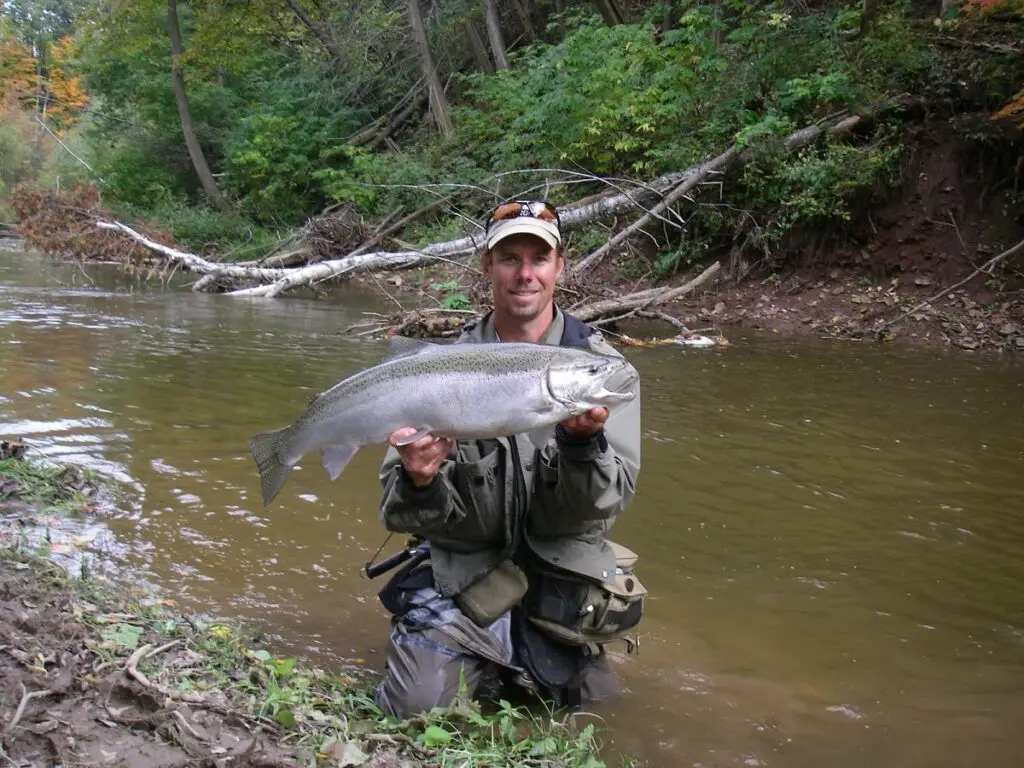
As a fishing guide and fly fishing instructor, I have taught thousands of anglers how to fly fish. I have done many one-on-one lessons and also do classes with up to 20 students.
As a new fly angler, learning from seasoned fly fishing instructors and guides means you learn the right stuff and you learn the right way!
Fly fishing for beginners is all about knowing what to use and how to use it. That includes the right fly rods and reels, essential river gear, flies that work for each species, the best methods to use, how to cast a fly, and how to fish it all effectively.
There’s more! Actually, there’s a lot more that you need to know if you want to be successful early in your fly fishing adventure. I’m going to break it all down for you the same way that I do in my “fly fishing for beginners” classes, and when I teach new fly anglers one-on-one.
There are so many things included in this article that I wish I had known when I started fly fishing over 35 years ago.
Not only that, but if you have a question, let us know in the comments section below and we will answer it for you.
What Is The Difference Between Fly Fishing And Regular Fishing?
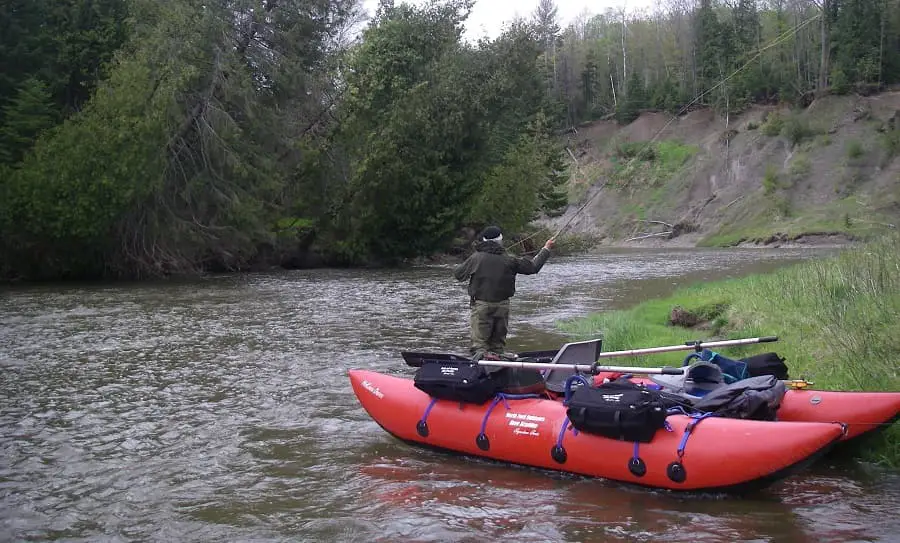
When I start my fly fishing classes or when I start my one-on-one fly fishing lessons, I start by answering the question, “what is the difference between fly fishing and regular fishing”?
The simple answer I give is that with regular fishing, the weight of the lure or bait carries the line out to the fish, but since some flies are as small as a mosquito and are virtually weightless, you can’t cast them with a regular fishing line so in fly fishing the weight of the fly line carries the small weightless flies out to the fish.
With nearly weightless flies, fly anglers have the ability to fish floating flies on the surface of the water, or submerged flies below the surface.
Is Fly Fishing Hard To Learn?
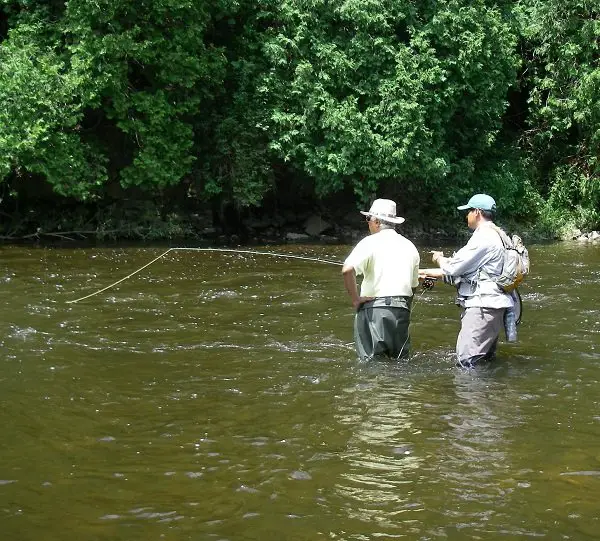
A common misconception is that fly fishing is hard to learn, and it can be for some anglers, but, it can also be easy if you know where to start and what to focus on.
The truth is, I have had clients that have never even touched a fly rod catching trout in less than 5 minutes.
I’ve had young kids under 10 with almost zero fly fishing experience catch over 20 trout in 6 hours. You might be asking, how is this possible?
It’s simple: use an easy method and follow a step-by-step process.
Years ago, I did what every other guide and instructor did and I taught new clients to cast first. Most guys would think this is the obvious first step, but is it?
Sometimes I would have new fly anglers practice their casts for an hour or two until I felt they were good enough and safe enough to tie on a real fly and fish.
But, I then realized while my clients were learning how to cast all morning, they were missing the best and easiest fishing of the day. Even though they could cast, they now struggled to catch less active fish.
So, I thought to myself, what fly fishing method could I use that was super easy to do that anyone could do it, but still had the potential for a fast hookup?
The first time I tried this new strategy of fishing first, and learning to cast later, my client had his first fly-caught fish in about 10 minutes, he was very happy and was surprised at how easy it was.
He then caught many more fish over the next few hours, and he still had no idea how to cast a fly rod. You see, there are many different types of casts in fly fishing, and everyone tends to start with the more advanced casts because that’s what they see in the video.
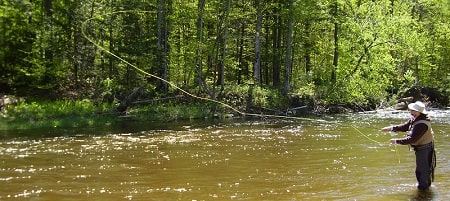
But that cast is not required to fly fish and catch fish, not at the beginning anyway.
Once I stopped teaching fly casting first and had clients catching fish faster, I never went back to the old way of teaching new anglers how to fly fish,
and this resulted in most of my new anglers catching a lot more fish in a day. Isn’t that what we all want anyways?
So you can make it difficult if you want but keep reading and I’ll reveal what method I now start with and recommend all new fly fishers start with.
There are many things a new fly angler needs to know eventually, but, it’s a step-by-step process, so starting with an easy but effective method is a highly recommended way to go.
What makes fly fishing for beginners hard is not knowing the proper steps and methods to use, and then hitting the water and trying all kinds of stuff that just doesn’t work or you just don’t have the required skills.
As a fly fishing guide, I my clients use a step-by-step process, using one thing at a time, which takes the confusion out of fly fishing and builds confidence and skills.
How Much Does It Cost To Start Fly Fishing?
This is a common question and the answer will depend on a lot of things.
The short answer is that you could pay as little as $70 for a low-end complete fly fishing outfit, up to $400.00 for a midrange outfit, which could include waders and release tools, or it’s possible to spend over $3000.00 on all the best gear.
How much it costs to get started in fly fishing is also depends if you already have some of the river fishing gear like waders and boots and a vest or pack.
It may cost more for some types of fly fishing, especially if you’re looking for fly fishing outfits for fish like salmon, steelhead, and saltwater fishing. You will likely need to spend more for that type of fishing than you would if you were just fishing your local rivers for trout, panfish, and bass.
Learn more at: How Much Does It Cost To Start Fly Fishing And How To Save Some Money
Quick Beginners Guide To Fly Fishing
Before I get into the easy first steps, consider these tips from our guides to help you as a new fly angler.
- Use the right gear: It’s important to use the right gear for the species you want to fish for, and for the type of water you plan to fish. There are fly rods and fly reels, and lines, that are designed for small trout, or for 40-pound salmon, or 200-pound tarpon. You do not want to use a small trout fly rod on large salmon, and you don’t want to use a salmon rod on small trout. Using the right gear makes learning easier. I will discuss proper gear shortly.
- Be patient, and don’t expect too much at first: You will not catch a lot of fish at first unless you are standing beside a great guide. Therefore, with patience and practice, fly fishing will get much easier.
- Practice casting and your presentation: Every sport requires practice if you want to get good, and so does fly fishing. Casting practice will enable you to get your fly to the fish so it’s important for most fly fishing methods. However, once your fly lands on the water, working on your presentation will help you catch a lot more fish. Some say “presentation is everything!”
- Utilize fly shops: The local fly shop doesn’t like me to tell you this but I tell my clients to pick the brains of your local tackle and fly shop employees. They are a wealth of information on local fishing because chances are, they all fish a lot. Not only that, but they likely have a lot of regulars that come in and give them reports on river conditions, hot spots, and what flies the fish are biting on. They should even know some of the rules and regulations.
- Local Guides: You do not always need to hire a guide to get tips from the guide. Often, you can find hints and tips on local guide’s websites too. As an example, look at what rivers they guide on, those are usually good rivers to fish. Sometimes guides will also have their favorite flys shown on their website or social media pages, and some guides even have blog pages with tips and advice. This is all free advice from guides; however, I can not stress enough the value of actually going out with a good guide, having them stand beside you and coach you along. If they are a good guide you could learn more in 1 day than you might learn in 5 years on your own. Check out our guide page to find a good guide in your area.
- Awareness Of Surroundings: It is important to slow down and look around for clues about the fishing. This means “the bugs and the water conditions”. Look in the air or on the water to see what bugs are around, this can help to determine if the fish are feeding on them or not. Look for rises on the surface or flashes of white or silver below the surfer, both indicate feeding fish. Water conditions like clear or dirty water might dictate what fly fishing methods you should try.
- Be Quiet, and Learn To Position Yourself Properly: A simple tip to fly fish better that I provide to all my new fly fishing students is to position yourself in an area that enables you to get a great presentation but not let the fish see you or so you don’t spook the fish. Where to stand is one thing, but moving quietly, staying behind the fish, and only getting as close to the fish as you need to is essential for catching most big fish. GUIDE TIP: A big mistake many new and more experienced anglers make is rushing into the pool and spooking all the big fish before they even make their first cast. SLOW DOWN, determine the best approach, and move slowly and quietly, and you will catch more fish.
- Handle Fish Properly: Releasing fish ensures that the good fishing you are experiencing stays good. This means you need to learn to handle the fish properly so they swim away healthy. It also means learning how to net the fish well.
Common Species To Fly Fish
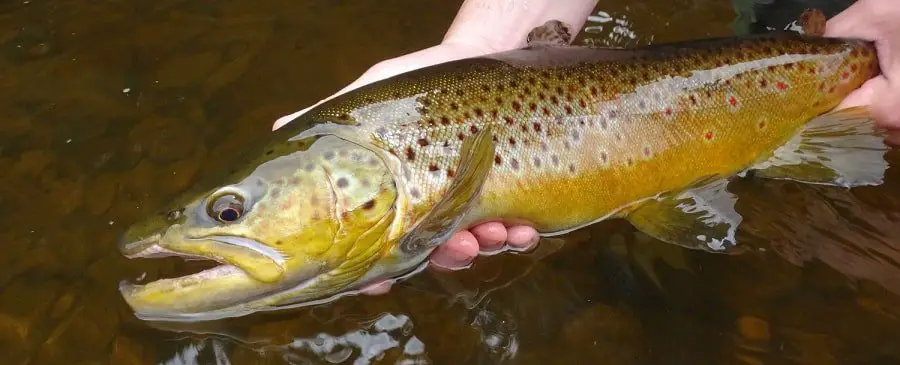
Beginner fly fishing anglers might ask what fish can you fly fish for? The simple answer is almost any fish can be caught fly fishing.
Even though you could fly fish for any species, I would not recommend learning to fly fish for a very difficult fish, or a very large fish at first.
Instead, beginner fly fishermen should start fishing for more abundant and easier-to-catch fish like trout, panfish, and bass. These species are usually very abundant and the easiest to catch.
In most northern countries, especially in the USA and Canada, the most common species for fly fishing are trout, steelhead, salmon, and bass.
Anglers also do saltwater fly fishing using big saltwater flies; however, this is often not easy fly fishing for beginners and is not recommended.
Other species, like musky or large pike, require very large streamer flies that give even more advanced fly casters a difficult time. As a beginner avoid these species for now.
GUIDE TIP: If you are learning how to fly fish, do yourself and favor and fish for easy and abundant fish.
Essential Fly Fishing Gear List
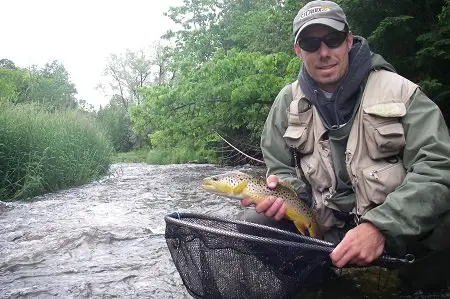
The five Essential fly fishing items are a fly rod, a fly reel filled with fly line, a leader, and flies that are suitable for the methods and the type of fish you want to catch.
Just those five things are all I would need to fly fish and catch fish. However, there are a lot of other important things that I would also use and recommend to improve your fly fishing experience.
I will discuss them all below.
Fly Rods For Beginners
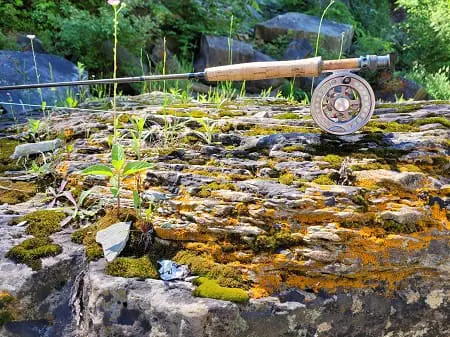
Fly rods come in lengths from 6 feet to 14 feet. However, the most common length for a fly rod is 8 to 9 feet long.
It may sound very long to a spin fisherman, but it’s not that long once you get used to it.
The best fly rod for beginners is an 8’6″ to 9-foot fly rod. This rod length is most popular for most methods and is relatively easy for beginners to cast.
Fly rods also come in weights ranging from 0 to 14. This is a weight rating system that helps anglers match up the rod to the size of the line, the size of the reel, the size of the fish, the size of the water, and/or even the size of the flies.
As an example, fly lines are also weighted using the same rating system, and this ensures the rod casts properly. As an example, you would want to use a 6-weight fly line with a 6-weight fly rod.
When it comes to the fly rod and line weight, the lower the number the smaller the flies and the smaller the fish you can fly fish for.
A fly rod from 0 to 3 would be best for panfish and smaller trout, and would also be good for very small and light flies. A 10-weight rod would be more suitable for large salmon or big musky flies but would be way too heavy for small brook trout or panfish.
The perfect rod would depend on the species of fish and the river you fish, and maybe the methods you want to use. If you want more details on the best weight rod for trout, click HERE.
In order to get the perfect fly rod for you, you should determine:
- Type and size of fish you want to fish for
- Type and size of the water body you will be fishing
- Method or methods you will be using the most ( many rods can be used from multiple methods)
- Size of the flies required to catch the fish
My recommended general purpose fly rod for beginners would be a 9 foot 5 weight rod. But, see the list below to know what best suites your needs)
- 1-3 Weight: best for Panfish, small trout, dry fly fishing, and small streams. ( best for dry fly and very light line nymphing)
- 4-5 Weight: good for small, medium to large trout, bass, and nymphing, small streamer fishing, ponds, small to mid-sized streams and rivers, ponds, and lakes. ( 4 weight is my go-to trout rod)
- 6 Weight: The most recommended rod size for multi-purpose fishing. Almost too big for small trout, but too small for steelhead or salmon. Good for medium-sized fish, 1 pound to 7 pounds, good for bass, and great for medium to large rivers, lakes, and ponds. Great for small to medium and medium-large streamer flies up to 5 inches. (6 weight fly rods are my go-to streamer rod size for trout and small-mouth bass)
- 7-8 Weight: steelhead, salmon, pike, bass, carp, large flies, bigger water, big rivers, and lake fishing. (7 weight is my go-to size for great lakes steelhead, and 8-weight is my go-to size for west coast steelhead and great lakes salmon.)
- 9-10 Weight: large salmon, musky, and saltwater fish. Huge streamer flies and very large rivers, lakes, and ocean fishing.
- 10-14 Weight: This is a very big heavy fly rod that can be good for anything larger than salmon, such as Baracuda, Tarpon, and most saltwater fish. Some anglers will use 10-weight rods for musky due to the huge 7 to 12-inch flies.
You have many options for fly rods, You can also start with one of the fly rod and reel combos I recommend, or you can try my recommended fly rods for steelhead or for trout and for salmon .
Fly Reels For Beginners
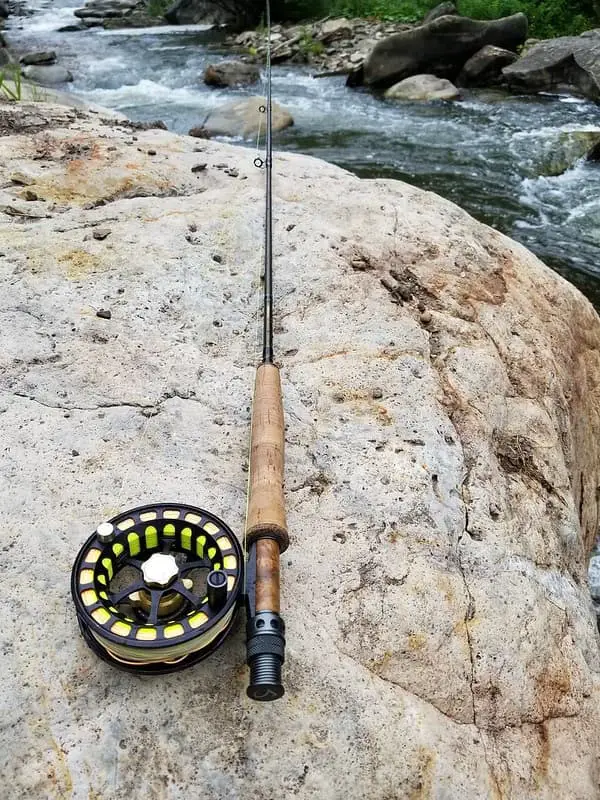
Fly reels are required to hold the fly line and to reel in the line when needed. They also aid in landing big fish.
Some fly reels have a built-in drag system, and some have a light clicker system known as click-and-pawl and are designed so that you can use your palm as the dag.
GUIDE TIP: I highly recommend a fly reel with a good disc drag system for fly fishing beginners. Disc drag reels can be inexpensive and under $100, but they are worth it and much better than click-and-pawl reels. I have seen too many anglers lose big fish on reels with bad drags or no drags reels like the click and pawls.
It’s best to match the reel to the rod size.
Large arbor reels are best on larger rods for bigger fish but are not usually required for smaller fish and smaller rods under 5 weight.
Fly Lines For Beginners
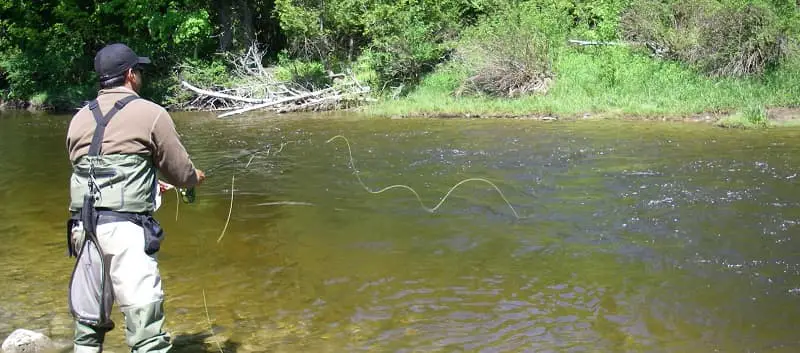
What makes fly fishing so different from all other fishing methods is the fly line.
Fly line is thick and made of a strong inner core line which is covered by a relatively soft flexible but durable plastic coating.
It’s the thick heavy fly line that allows us to cast nearly weightless flies over 60 feet.
I’ve already mentioned that fly lines use a rating system to match the fly line to the fly rod for the best casting performance.
Fly lines are typically 90 feet long and require another line attached to them called fly line Backing. I’ll explain backing in a moment.
There are different types of fly lines to consider. The most common fly line, and the one I recommend for new fly anglers is a floating fly line. Floating fly lines are easiest to cast and are good for both top-water and below-the-surface fly presentations.
There are also sinking fly lines and partial sinking fly lines, which are normally used when fly fishing in lakes or ponds, and these sinking lines will help sink your fly deeper so you can get your fly down to the fish.
Fly lines are also often tapered, with the two most common tapers being weight-forward lines and double-taper lines. The most common taper is a weight-forward fly line.
The weight forward fly line means there is a thicker section near the front of the line (closest to the fly) and this extra weight helps with fly casts. For this reason, weight-forward floating fly lines are the best lines for beginner fly anglers.
Most fly rod combos come with fly lines already on them, and they will usually come with a weight-forward floating fly line.
Fly lines range from about $20 to over $100, but if you want to start fly fishing, most lines in the $40 to $60 range should be good enough. More expensive fly lines are either specialty lines, or they will float better or perform better than cheaper fly lines.
Fly Line Backing
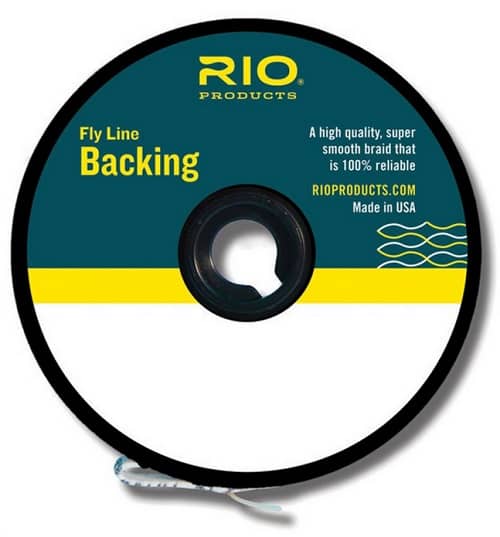
Because fly lines are so thick, they are made short, with an average fly line being 90 feet long.
The problem with such a short line is that if a big fish runs far, it could take all your fly line with it, which is not good since fly lines can be expensive.
Therefore, we add a thin but strong line called Fly Line Backing, which goes between the reel and the fly line. Backing not only adds another 300-plus feet of line but it also helps fill up the fly reel spool.
Leaders and Tippets
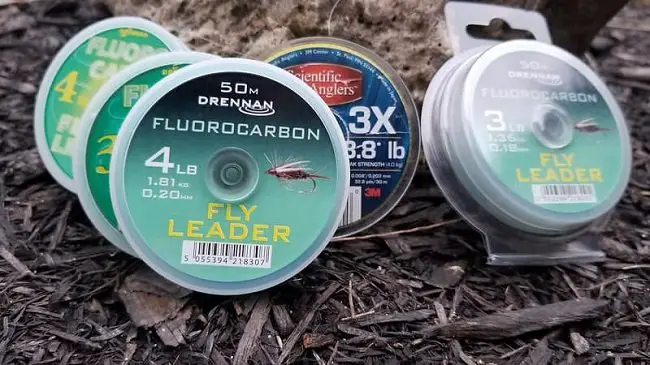
The fly line is thick and colorful, and therefore, we can’t tie it directly to the fly.
Instead, we add a tapered leader and often a short piece of tippet line which is where the fly is tied to.
The tapered leader is usually 7 to 9 feet of clear line that is thick at the top where it attaches to the thicker fly line and then tapers down to a thin section at the bottom where we attach the fly or a tippet line.
The thick upper section of the leader that attaches to the fly line aids in casting and helps straighten the leader out when the fly lands so the fly lands far enough away from the thick fly line.
The thick colored fly lines can spook fish so the further away you can keep the fly line the better. This is why I will use a 9-foot tapered leader with a 12 to 30″ section of tippet.
We often add about 12 to 24 inches of a thinner non-tapered line called a tippet to the bottom of the leader.
There is a reason for this tippet line.
If you just tie your fly directly to the tapered leader, each time you cut off your fly to add a new one, the tapered leader will get shorter and will get thicker and thicker as you keep cut away the thinner line at the bottom of the leader. If the leader line where your fly attaches gets too thick the fish might see the line and not grab the fly. This happens!
The tippet is all one diameter, so you can cut it multiple times without it getting thinner. This allows you to maintain a thickness that is ideal for being undetected by the fish.
Tippets come in small spools and it’s a good idea to have multiple spool sizes. Tippets can also greatly extend the life of your leader since you are cutting into your leader very little.
Fore more details on leaders and leader strength, check out What Pound Test Leader For Trout and What Pound Test Leader For Steelhead.
Flies
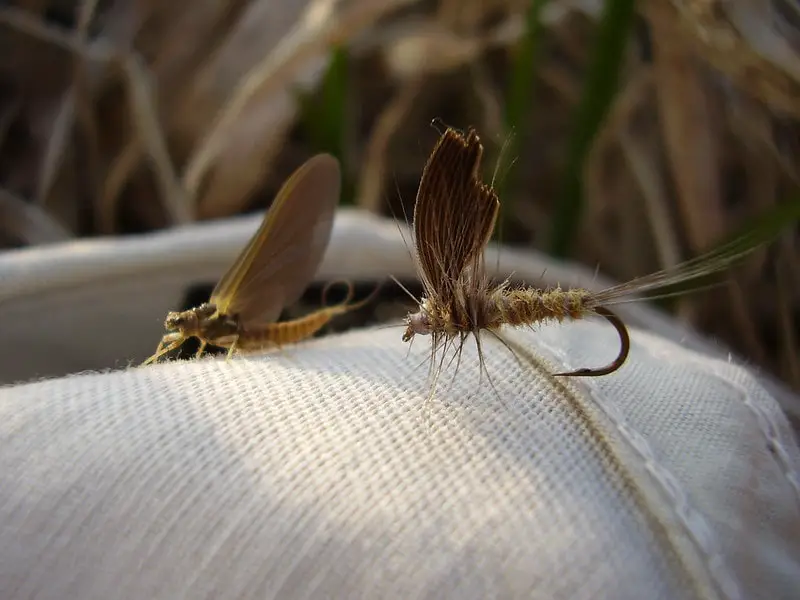
Why do we use flies? What do they represent? Where on the water do we fish them? Is fly selection important? These are common questions for anglers that want to know how to fly fish.
We use artificial lures called flies and we use them because they are light and we are able to cast them with the heavy fly line. Sometimes the flies are extremely small and less than 3/8 of an inch long.
Although they are called flies and are often thought to just imitate the small aquatic insects that live above or below the surface of the water, but, artificial flies can also imitate fish, crayfish, leeches, frogs, and even mice, or pretty much any trout food source.
There are many different types of artificial flies for trout, for steelhead, and for salmon, just click the links to see my recommendations and most effective flies.
I’ll have an article on salmon flies coming soon.
Dry Flies
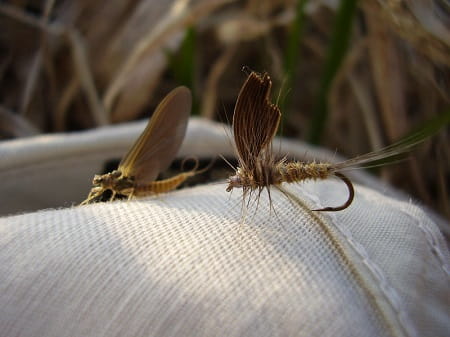
Dry flies float, and they are flies that imitate the bugs found floating on the surface of the water.
Dry flies are meant to be fished on the surface. Dry flies can imitate aquatic insects such as Mayflies, Stoneflies, and Caddis, or even insects like beetles, ants, houseflies, bees, or grasshoppers.
Dry flies are designed to be used with the dry fly fishing method discussed below. For some of the most effective dry flies click the link.
Wet Flies
Wet flies are flies that are basically dry flies sunk just below the surface. They are designed to be used with the wet fly fishing method I will discuss below. Wet flies have been around since the 1800s, Wet flies can be used on almost any fish species in the river.
Nymphs
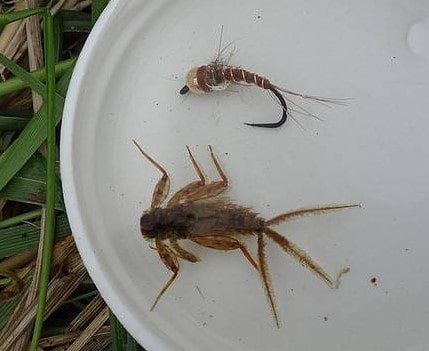
Below the surface live aquatic insects known as nymphs. Nymphes are often the young and immature stages of aquatic insects like mayflies, stoneflies, and caddis.
Soe nymphs such as Isopods and Scuds live their entire lives below the surface, whereas the other nymphs listed above will mature into flying adults.
Artificial nymph flies will imitate these natural below-the-surface insects.
Guide Tip: Many anglers believe you need to match the look and shape of the live nymphs as best as possible. At times this is the case, but, as proven by many guides and some of the best competition anglers in the world, you do not need exact matches. In fact, crazy flashy nymphs that look nothing like the real nymphs can be fantastic.
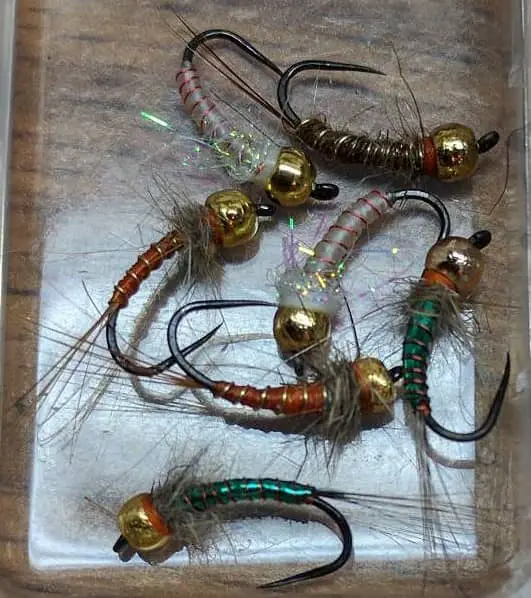
I tell you this as a new angler so you do not stress over always needing to have the exact matching nymph.
This picture of my assorted nymph patterns shows a bunch of flashy flies that work very well for me. Often my most effective patterns have gold, silver, and copper beads for attraction.
Nymphs are designed to be fishing with a few different Nymph fishing methods, which I discuss below.
I mentioned earlier about a method I use with brand new anglers to get them to catch fish quickly.
It’s these nymph flies and an easy but effective nymphing method that I now use first with new fly fishers to get them to catch fish quickly. I will discuss this method below.
Another bonus with nymphs is that trout tend to eat nymphs all year long and small nymphs are a great way to catch wary trout.
The good thing with nymph fishing is the cast distance is also usually short and you do not need to know the basic overhead cast.
Nymphs will trick fish most of the time and small fish have a hard time resisting them.
Streamers
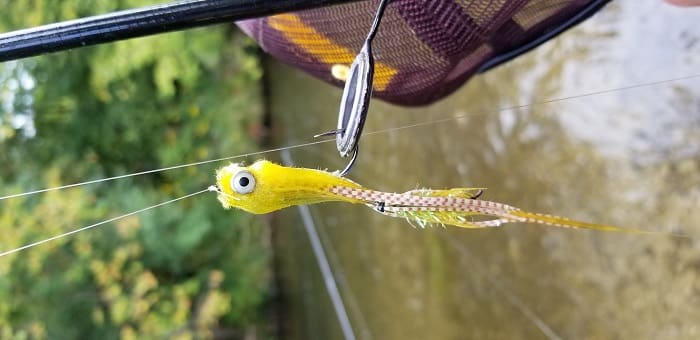
Streamers are often your biggest flies and are made to imitate minnows, leeches, crayfish, or other larger prey that swim.
Most streamer flies will be 2 to 4 inches long. But micro streamers and XXL streamers can also be used.
I mentioned 12-inch flies earlier, well, they were musky streamers and they were made to represent larger prey that musky will eat, such as perch, walleye, and even bass.
You could use the streamer fishing or trout, steelhead, and salmon, but it is advised that new anglers get good at casting first with smaller flies before they attempt larger streamers.
Non–Essential Fly Fishing Equipment
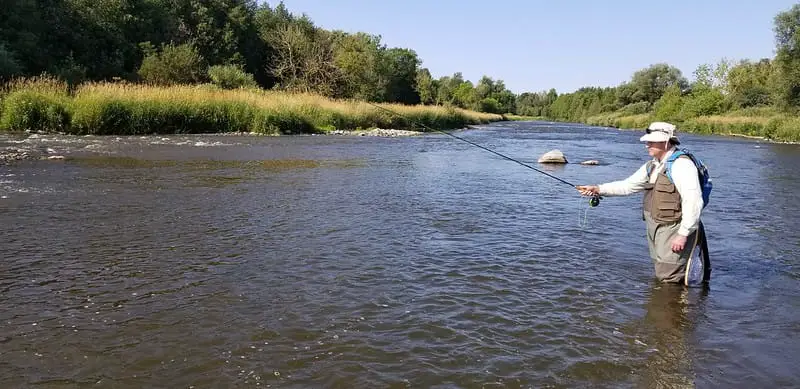
All you need to fly fishing is a rod, reel, fly line, leader, and a fly!
But, there are other things I could not do without on the river. These other things will just make your fly-fishing adventures so much better and much more effective.
Waders and Boots
Keep your legs warm, dry, and protected with waders and wading boots.
Waders keep your legs dry and comfortable, but they also protect your legs from cuts and scapes, as well as insects like mosquitos and ticks. Not to mention protecting you from poisonous plants like poison ivy.
Good wading boots will also offer more ankle support which is needed when walking the trails and rocky river bottoms.
There are two types of waders, Bootfoot, and Stocking Foot waders. These can be made from a few different types of materials.
Bootfoot waders, although common, generally do not offer a lot of ankle support, but they are usually easy on and easy off and do not require a separate set of boots. They are also more budget-friendly.
Stockingfoot waders require you to purchase a wading boot to go over top of the foot sections of the waders. The wading boots generally offer a lot more ankle support and these waders tend to be a lot more comfortable.
However, when the waders and boots are combined they generally cost more than Bootfoot waders.
FYI, If you can’t decide on Bootfoot or Stockingfoot waders, you should know this. Almost ALL river guides, ALL competition anglers, and ALL experienced river anglers will use stocking foot waders.
Some waders are good, some are not.
I am generally not a fan of neoprene waders but even neoprene waders have a time and place such as winter fishing.
I’m also not a fan of cheap vinyl waders however, they do work, are often fairly durable, and are good for low-budget or very casual anglers.
NOTE: Super cheap waders are often more trouble than they are worth and will usually leak quickly.
For this reason, there are only some waders from some brands that I do recommend, and others I won’t recommend. To date, I have probably tried and tested over 20 different waders and boots.
Find out the waders and boots guides recommend to their clients and friends at:
- 7 Best Waders For Steelhead Fishing – Guides Advice
- 3 Best Waders For Winter Fishing: Guide Tested Waders
Wading Jacket
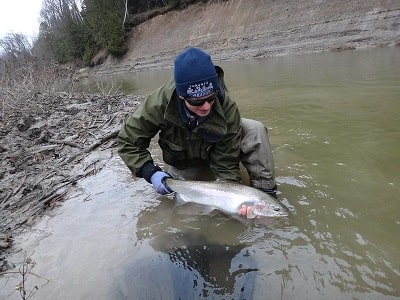
A good wading jacket is great for keeping the elements out, especially when the weather is colder or wet.
A good wading jacket will be wind-resistant and waterproof.
Just about all river guides will use a wading jacket when needed.
Wading jackets also tend to have plenty of pockets for your gear and are made short so you can wade deeper in the water without submerging your pockets.
Packs and Vests
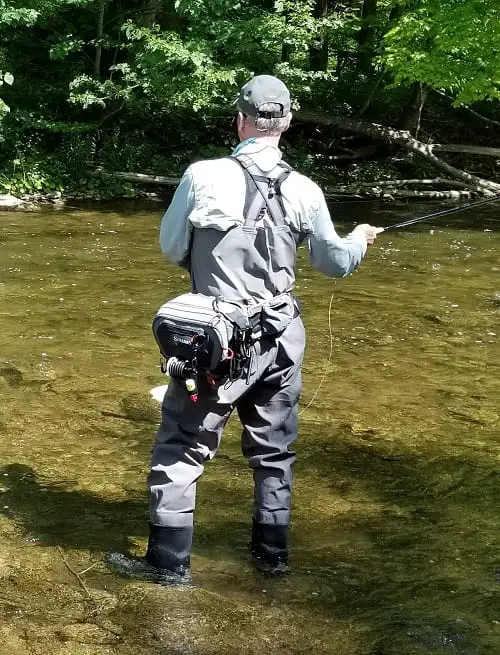
Fly fishermen and river anglers normally do not carry their stuff in tackle boxes.
Part of the reason is that when you wade out into the river, you need to leave all your stuff in your tackle box on the bank.
And if you hook into a big fish and the big fish runs far down the river, your tackle box will be left unattended on the bank and could get stolen.
Instead of a tackle box, or tackle bag, river anglers carry all their stuff in a fishing vest or a fishing pack so that all their stuff stays with them at all times. Vests and packs are great ways to keep everything organized. Click the links to see the ones I recommend.
Fly Boxes
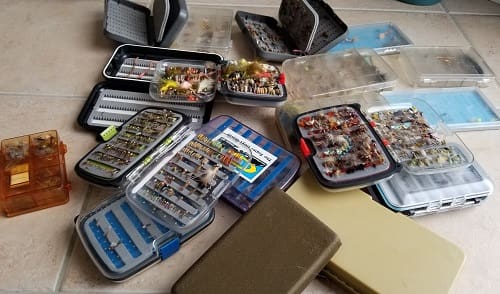
Got flies, well then you will need to organize and store them in a fly box.
I prefer and recommend waterproof fly boxes and boxes that secure each fly separately. The reason for this is that if you drop your closed box in the water it won’t soak your flies. Soaked flies can and will rust!
Also, flies that are individually secured are easy to keep organized, and easier to grab, and should you drop an open box on the ground or in the water they won’t all fall out and cause you to spend an hour picking up 300 small flies.
Yes, I said 300 flies. Some boxes will hold a hundred flies, and some fly boxes will hold over 600 flies.
Landing Net
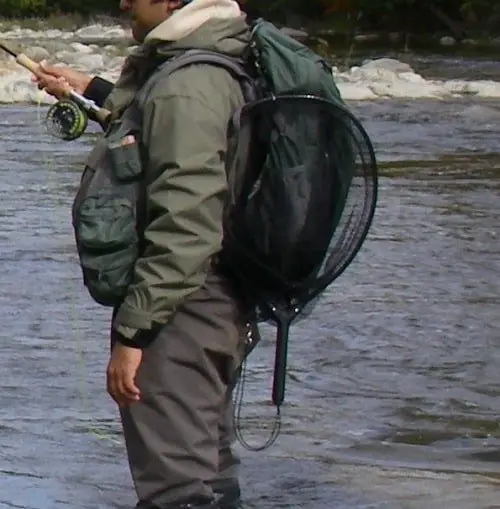
Honestly, although not an essential item, I can’t stress enough how important a landing net is to a fly fisherman.
I don’t know how many times I’ve heard stories of guys telling me they fight fish for 20 minutes and then realize they just lost a fish of a lifetime and that if they only had a net with them they would have landed it.
Not only that, but if you plan to release trout healthy, a net allows you to keep them submerged while you get the flies out of their mouths.
Guide Tip: Air kills 95% more fish than the fight or the hook. So keeping the fish in the net and below water is critical for the survival of the fish. Every year we can catch the same 20 to 26-inch brown trouts sometimes over 10 times due to proper handling and release methods. And we also catch the same fish year after year.
If you want to land fish more consistently, or just want to be sure you land your first fish, get a decent net.
Check out Best Landing Nets For River Fishing.
Polarized Sunglasses
I could not do my job as a guide as well without a good pair of polarized glasses. Anglers and guides use them to protect their eyes, for reading water, and sometimes for spotting fish.
Polarized glasses cut the glare on the surface which also makes seeing flies and indicators much easier.
A good pair of Polarized glasses are an invaluable tool in my opinion.
Miscellaneous Fly Fishing Accessories
These are other items that come in handy when fly fishing. Some are almost must-have items.
Knippers:
Knippers or line cutters are used a lot when changing flies or adding tippet to leaders. A good pair of Knippers is an almost must-have. They are easier and faster than scissors.
Stream Thermometer
A stream thermometer is something just about every fly guide will have in their pack and so should you if you fish throughout the 3 or 4 seasons. Since trout, steelhead, and salmon are temperature sensitive it’s good to know if water temperatures are ideal for fishing or if you are just wasting your time.
Forceps: Aka Hemostats
Sometimes flies get deep in the mouths of the fish and the only way to get them out is with Forceps. Therefore I highly recommend a force suitable for the size of the fish you fish for. Thin long forceps are best for very small trout.
Fly Floatant
If you dry fly fish, fly floatant will be applied to your dry flies and will keep them from getting waterlogged, and it will keep them floating higher and longer.
Normally, I have found the higher your dry fly floats, the better it works. I use a combination of a fly floatant and a desiccant on my flies to dry them out and to keep them floating high. I tell you how I do this on my Best Fly Floatants page.
Weights For Fly Fishing
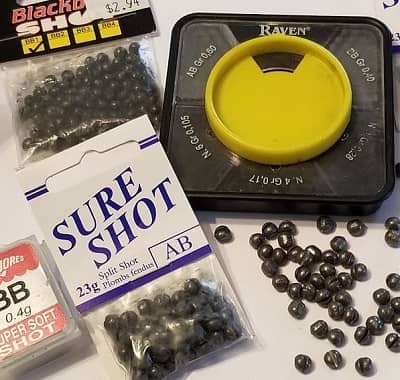
If you plan to nymph fish at all you will likely need weights called split shots. I use good quality dark or dull colored split shots a lot when I’m using subsurface flies.
There are different types of weights but split shots are what the guides and experts use.
These weights will help get your fly down to the fish and are often a must-have in deeper or faster currents.
I sometimes add a split shot just above small streamer flies to get them deeper.
Indicators
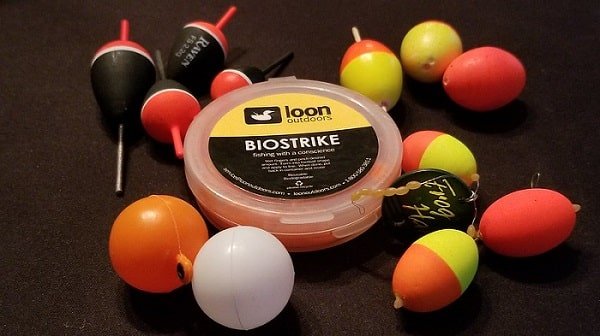
Indicators are like mini bobbers and are mostly used when nymph fishing for trout, steelhead, and salmon.
In fact, more guys use indicators when fly fishing for these species than not.
Indicators simply indicate when you have a bite, well, at least that’s what most guys think.
However, this is not entirely true. Expert indicator fishermen and I also use specific indicators to suspend the fly, control fly speed, and help determine leader angles so I and my clients get a better presentation and therefore more fish. Click the link to learn more.
Indicators can also be used when dry fly fishing for guys that have difficulty seeing the super small dry fly. A very small indicator can be paced 24 to 36 inches from a micro dry fly to help you know where that fly is when it’s 30 to 50 feet away from you and you can’t see it.
Fly Fishing Gear For Beginners.
That’s not all. There are other things you may eventually need, such as sun gloves, winter gloves, buffs, hats, sunshirts, hoodies, and even proper clothing to layer under your waders.
If you want to know more about all the fly fishing gear anglers and guides use and recommend, which includes all the stuff I mentioned above, check out Fly Fishing Gear: Everything You Need To Fly Fish
The Fly Fishing Set up
There are many types of setups for fishing flies. Different methods will require different setups so I will show you these setups below.
Fly Fishing Knots
There are a ton of knots that fly anglers could use, but when I’m teaching fly fishing for beginners I keep it super simple and tell my students that you really only need to know two or three basic knots.
One knot is for tying the fly to the tippet or leader. For this, I recommend the Improved Clinch Knot, however, the double Davy Knot is the one that I use the most.
Or, the other knot which fly anglers use a lot to tie two pieces of line together, like when tying your tippet to your leader, is the Triple Surgeons Knot. I use this all the time, however, for tying two lines of very different sizes, I use a Double Uni Knot.
Even advanced anglers will use these knots so they are not just for beginners.
Alternative knots that I use are:
- Davy and Double Davy Knot – A fast strong knot for tying a fly to line. This knot was introduced to me by George Daniel, author, head coach of the youth fly fishing team USA, and Competition multi-medal winner. I use this knot more than any other fly-to-leader knot. The Double Davy Knot works for big fish like steelhead and salmon.
- Double Uni Knot – A smooth strong knot for tying two pieces of line together.
There are some good knot tying tools available, or you can just practice knot-tying when you are at home watching the game or chilling out.
Basic Fly Casting
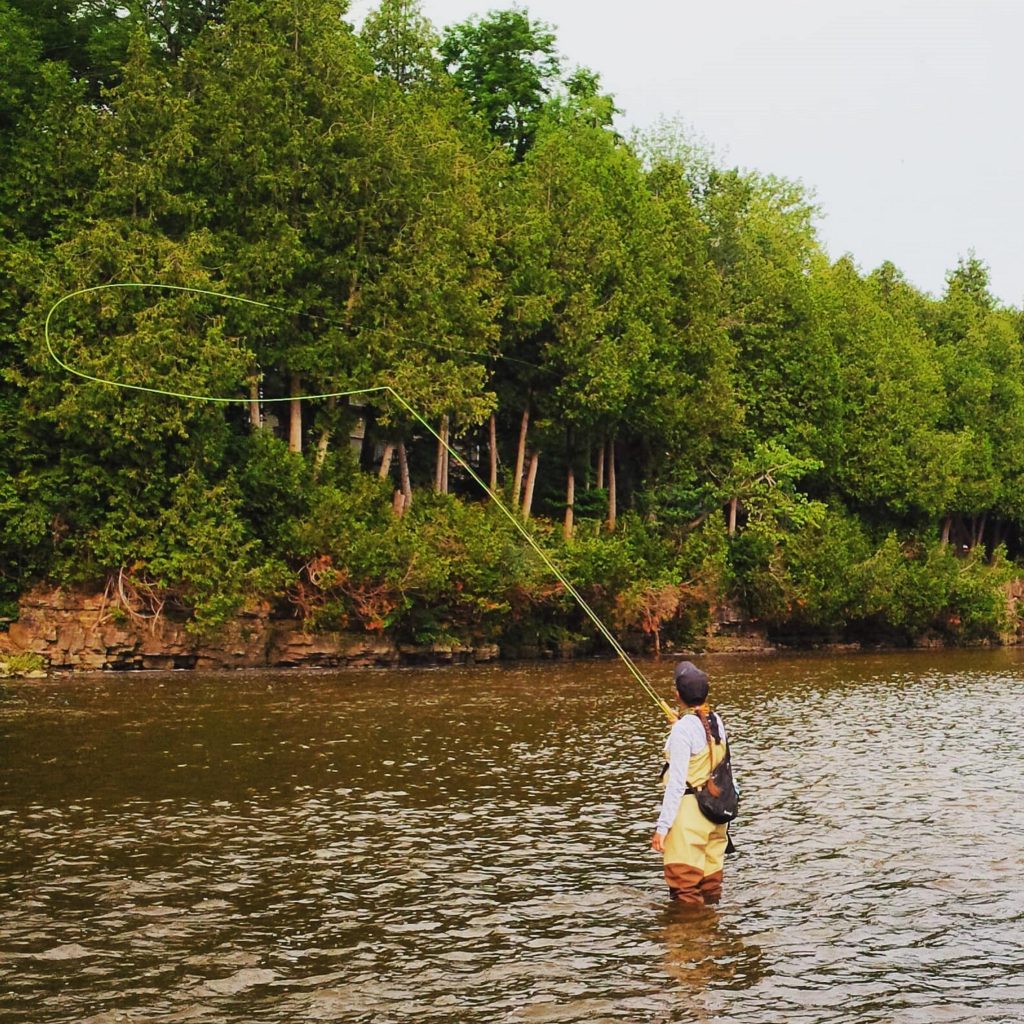
Fly casting can often be the most difficult thing in fly fishing but once learned it’s actually very easy to do, and doing it well means catching fish more often.
The angler in the picture is a student of my good buddy Mike from Metcalfe School Of Fly Casting. Although not a requirement, having someone teach you to fly cast is a good idea.
There are two main fly casts for beginners, the roll cast, and the overhead cast which is shown in the above image. Both are required for catching fish depending on the conditions.
The overhead cast, also known as the standard fly cast or basic fly cast is the one you see most often where the fly line goes forwards and backward in the air. This is a great cast for distance and is used with most methods.
With the overhead cast, you need almost as much space behind you as you want to cast forward. However, when you are limited backcast room anglers will use a roll cast.
The roll cast is much easier to learn and is normally only used when you can not do a back cast.
Fly Fishing Methods
There are multiple methods for dry fly fishing that new anglers might need to know. The method you use will depend on the fish and the conditions.
Dry Fly Fishing For Beginners
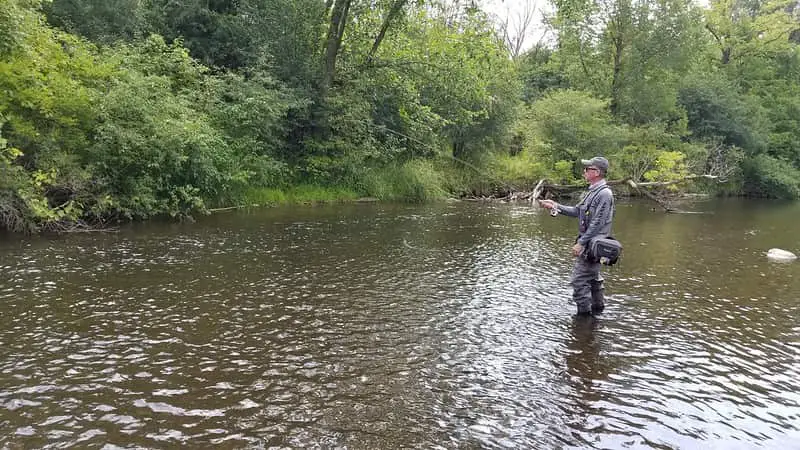
Dry fly fishing is when you fish or float your fly on the surface of the water. Anglers use this method when trout or other fish are grabbing floating bugs off the surface.
For this method, you simply watch where trout are rising for real bugs and then you cast a few feet from the fish and let it sit or let it drift past the feeding trout.
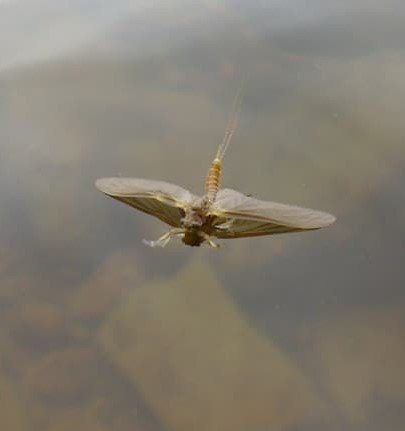
Common dry flies on many rivers are Caddis, Stoneflies, and Mayflies like the one in the picture.
Dry fly fishing can also be effective at other times and are not necessarily associated with surface insects.
As an example of this would be fishing with mice patterns that you twitch and drag across the surface for trout and bass.
Dry fly poppers can resemble frogs swimming on the surface, and these poppers can be great for bass, pike, or musky. There are also situations where large dry flies are fished for saltwater fish.
Wet Fly fishing
Wet fly fishing is an old method where you cast across the river with a subsurface fly and tighten the line and swing your fly across the river. Although it can be very good for big trout, on my pressured waters, wet fly fishing usually catches mostly smaller fish.
This method generally requires good fly casting but since you are only fly casting across the river, and not casting at a specific fish, you can practice casting with this method.
The fun thing with this method is that because your fly line is tight when the fish grabs you fly they hit it hard and you really get to feel the bite.
However, a variation of this known as swinging can be very effective for steelhead and salmon using a method called Spey fishing.
Nymphing
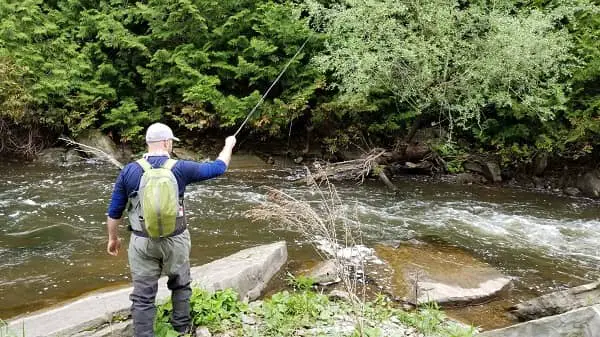
Nymphing is a way to imitate the dead drifting nymphs and aquatic insects and other food such as fish eggs that drift below the surface in rivers.
Nymphing is mostly done for trout, steelhead, and salmon, and at times, it can be the most effective method.
In fact, I mentioned early I am able to get brand-new fly anglers catching fish quickly without even teaching them the basic cast, and sometimes even catching fish on their first cast, and I do it with a nymphing method known as indicator nymphing.
With indicator nymphing you don’t do a basic cast, instead, you simply flip your line from below you, upriver above you, and then you let the indicator drift along with the current.
When the indicator stops and sinks you set the hook. It’s relatively simple, but there are ways to make it much more effective.
I use this type of nymphing with new anglers because it gets them familiar with the feel of the rod and line while providing a good chance to catch fish. Once they have caught some fish and are good and comfortable with the rod, I have found that teaching them how to cast is much easier.
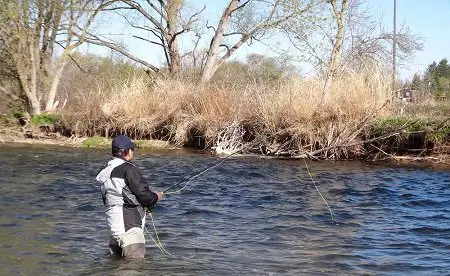
Two other nymphing methods include high-sticking or high-stick nymphing which I do not recommend, or the much-improved version of high-stick nymphing, known as Euro Nymphing.
Indicator nymphing is probably the most widely used and is very effective for trout, steelhead, and salmon. I go into detail about this method on my page Indicator Nymphing: 13 Tips From Expert River Guides
Euro Nymphing is what the world’s best competition fly anglers use and it’s one of my specialties. The reason the top anglers and I use it is that in a lot of river situations, it is a far more effective method than all other nymphing methods.
If you have never heard of Euro Nymphing and want to know more about it, just click the link.
Some of the best flies for nymphing are pheasant tail nymphs, stone fly nymphs, and the wooly bugger.
When nymphing, it’s not uncommon to catch over 10 trout in a few hours, or in some cases 10 in less than an hour.
Streamer Fishing
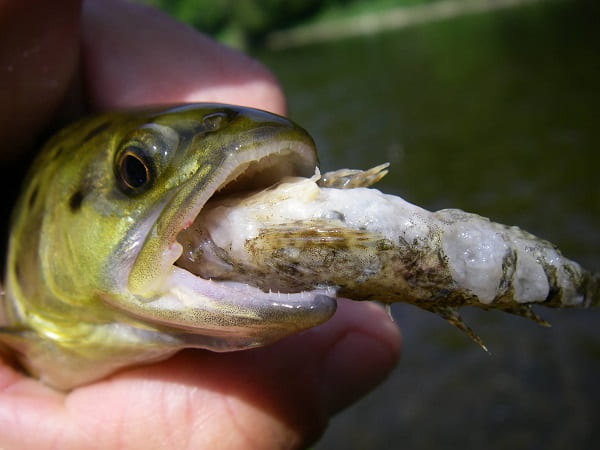
Most fish will eat other fish, whether that be small minnows or baitfish, or larger baitfish.
Even leeches, crawfish, frogs, and mice are all potential food for predatory fish.
We imitate these with flies called streamer flies and we use these streamers with a method known as streamer fishing.
Basic streamer fishing is simply casting out your streamer fly and then stripping it in. Stripping means pulling the fly line with you in short fast or abrupt pulls which cause the fly to twitch, jerk, and swim through the water. Your goal is to imitate the swimming prey or an injured baitfish.
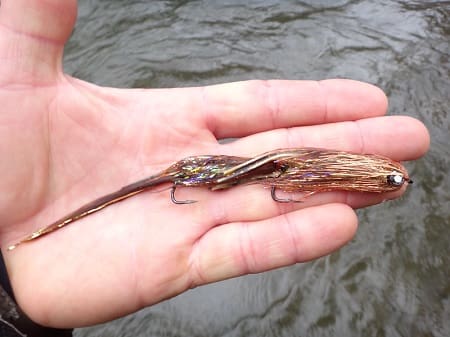
Streamer fishing is a little harder for new anglers since it requires good casting and a good distance with larger flies.
Larger flies are often much harder to cast due to their size, wind resistance, and their weight.
Streamer fishing can be used on just about any fish. I used them a lot for trout, salmon, steelhead, bass, pike, and musky.
Most anglers fishing lakes and saltwater will use variations of streamer fishing and streamer flies suitable to their target species..
Spey Fishing
Spey fishing is a method normally using two-handed rods for steelhead and salmon. It is meant for super long casts with zero back casts and is generally used for steelhead and salmon, however, smaller Spey rods are now being made and used for trout on larger rivers.
Although a new angler can do this, I do not recommend it for new anglers.
The Hatch: Bugs For Trout
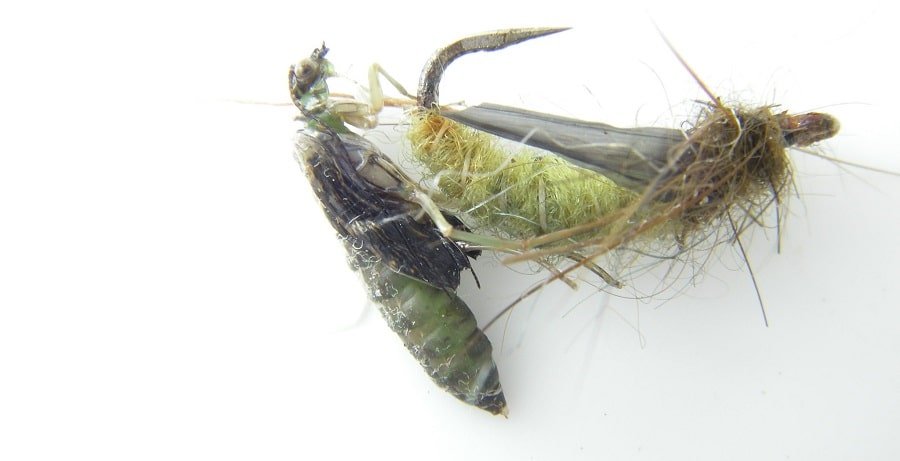
You may have heard are read something about a bug hatch, or matching the hatch.
I’ve heard anglers say they decided against fly fishing because they were told by someone that they would need to know all the bugs that trout feed on and when they hatch.
Part of the reason I started this website was because of bad information like this.
A hatch is simply a time when lots of the same species of aquatic insects get active and or transition from nymphs to adult flying insects all at once. It can also be when those flying adults return to the water surface to mate and lay their eggs.
This insect activity can trigger feeding frenzies and is a great time to be on the water.
For beginners, I tell them not to bother learning all the bugs, instead, all you need to do is determine the size and color of the insect you see on the surface, go into your fly box and find something similar. You don’t need to know the name of it, you just need to know where to land it and how to fish it.
I’ve ripped a piece of styrofoam off my coffee cup, cast it out, drifted it across the surface, and then caught trout. Meaning your fly does not have to be exact unless the fish are super finicky. In fact, many times, I will not match the hatch purposely because it’s not required, and using something totally different from all the natural bugs can really get the fish’s attention.
You also have help. Often, there are hatch charts for different rivers all over the world that tell you the size, color, and times when those insects will be most active.
Also, just stopping into your local fly shop and asking them what’s hatching and what flies they recommend is all you need to do. Have a decent assortment, match the bugs as close as possible, and fish it well.
Fly Fishing Ponds and Lakes
Fly fishing ponds and lakes can be a lot of fun. Growing up I was a long way from the nearest trout river for me but the local pond was loaded full of panfish and some bass so I was able to dry fly fish and streamer fish as well as practice my casting.
Lakes can be a great place to fly fish and anglers will target bass, pike, musky, and trout in some lakes. At times, dry flies will work, but for the most part streamer fishing is how most anglers will fly fish a lake.
Fly Fishing Rivers And Streams
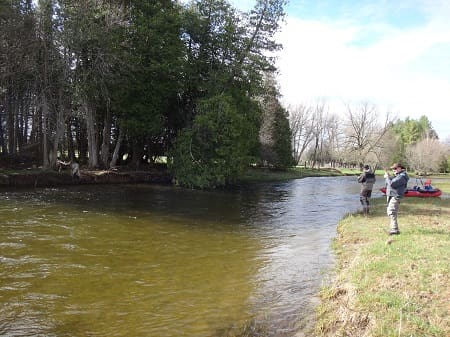
It’s hard to imagine a place better suited to fly fishing than fly fishing in rivers and streams.
There are just so many great fly fishing methods that work on rivers.
Every method I mentioned above works on rivers whether you are fishing for trout, steelhead, salmon, or warm water species like bass, pike, and musky. Anglers are now even targeting river walleye and carp with fly rods.
Rivers and streams are often the best spots for new fly anglers to learn fly fishing. Just find open water with not a lot of hanging trees and go have fun.
Also, find a river with an abundance of smaller fish and go have a blast. Catching smaller trout or panfish is easier than targeting large fish so these smaller fish are a good way to learn and build confidence.
There are tiny little creeks 3 feet wide that can hold some pretty big trout, and there are mid-sized rivers from 20 to 6 feet wide which are my preferred river size, and there are massive rivers that is almost a quarter a mile across.
All rivers and streams can be fished with flies. The trick is finding out which ones have good fishing and finding good areas on these streams where you can access and legally fish.
Finding The Fish and Reading The Water: River Fishing
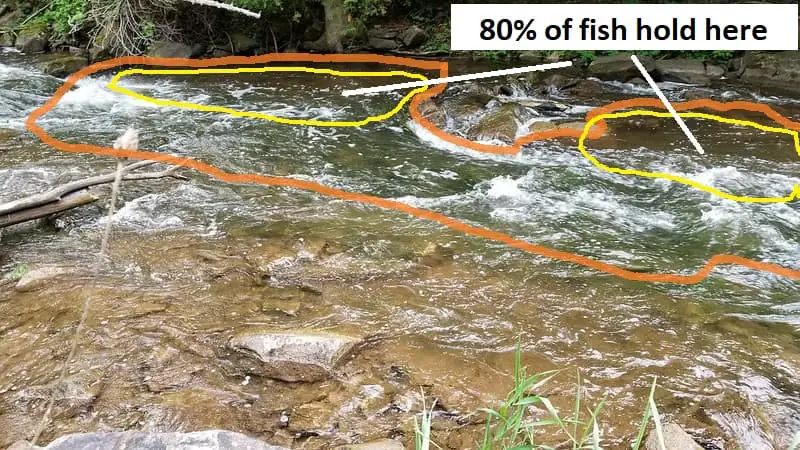
One thing I do well and different then the average angler is I see the water differently.
This is especially true in a lake where all you see is flat water.
But the truth is that guides and professional anglers visualize the structure. Structure often dictates where the fish will rest, hide, feed, and even swim.
In rivers, this is called reading the water and it’s much easier to do than in a lake.
Reading the water in a river usually means following the current and looking for deep sections, or structures such as rocks, logs, ledges or holes that fish will hold near.
There is a bit of trial and error involved, but once you understand the fish and where they like to feed, reading the water becomes easy, and so does finding the fish.
Fishing Rules and Fishing Regulations
Whether you want to fish a lake or river, often there are official rules and regulations you will need to follow to be fishing lawfully.
This may also include having a valid fishing license or maybe even a trout or salmon tag.
For this reason,, it is advised to check your local fishing regulations for your area to see what the rules and regulations are.
Fly Fishing Classes and Fly Fishing Lessons For Beginners
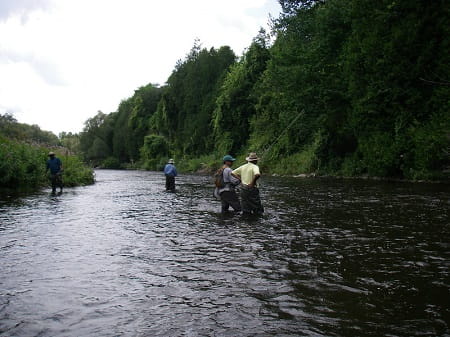
I do, and I don’t recommend fly fishing for beginners classes. Let me explain.
I think fly fishing classes and lessons are a great idea.
However, in many areas, fly fishing classes and lessons are done on stocked ponds which is great if you want to learn how to catch fish on stocked ponds.
Trust me, fishing on stocked ponds is very different than fishing on rivers. If your goal is to fish rivers, find a class that offers fishing lessons on the river.
A lesson can very quickly jump-start you in fly fishing and really shorten your learning curve. A lesson is a great way to learn the basics, learn how to cast, and it shows you what you need to practice.
I’ve found, and I’ve done this myself, that many anglers read something or see something and they go and try it and then practice it for years. Unfortunately, sometimes what you are practicing isn’t effective for your area or you are simply practicing bad techniques. Neither does you any good.
For this reason, fly fishing lessons are great because you at least have an instructor there helping you out and pointing out what you are doing wrong and what you should be doing instead.
But classes are also done in large groups and the instructor’s time is spent between all of you. For this reason, I do not recommend classes and lessons with many students.
But there is something that might be even better than a fly fishing class.
Hire Fishing Guides

I’ve been a fishing guide for 20 years and I have run many fly fishing for beginners classes for up to 20 anglers a day. Honestly, I hate doing classes.
Don’t get me wrong, one of the things I love the most about being one of the top guides in my area is teaching lots of people how to fish well.
But when I teach a group, by the end of the class I see how much each person has improved, and I’m often disappointed.
This is because, in my observation and opinion, you will learn far more in a one-on-one lesson with a local fishing guide than you will in a group or class. I see how much students improve in a class setting, and I see how much more students improve after doing one-on-one lessons, and the difference is huge.
When you get into small fly fishing classes with one guide and 6 to 10 students, your guide is only going to be with you a small percentage of the time. And sometimes, one person in the crowd will really struggle and take up a lot of the instructor’s time, leaving you with very little actual one-on-one instruction.
Think about it this way, in an 8-hour class with eight students, the instructor will try to be with each student equally, meaning you will probably only get about 1 hour of one-on-one interaction with your instructor.
But, with an 8-hour one-on-one lesson, you are getting 8 hours of instruction and all your guide’s attention. Therefore, you should be eight times more advanced and eight times better than the person in the class.
With a one-on-one lesson, a good guide will watch everything you do and will coach you step by step the entire time you are together. This is huge.
With a good guide, you will also learn the ins and outs and methods they use to catch fish constantly.
A good guide is invaluable and if I were to learn fly fishing or any sport from scratch, I would definitely hire a guide.
I know guides can sometimes be expensive so consider this, and I’m saying this from experience.
If I had spent the money on a guide from the start, I could have probably saved hundreds, if not thousands of dollars on the wrong gear, or useless gear, and even gas, not to mention how much time I would have saved practicing the wrong things and trying to figure everything out on my own.
Just something to think about.
Fly Tying
Fly tying is not required for beginner fly fishing anglers. Even an experienced fly fisher does not need to learn to tie flies.
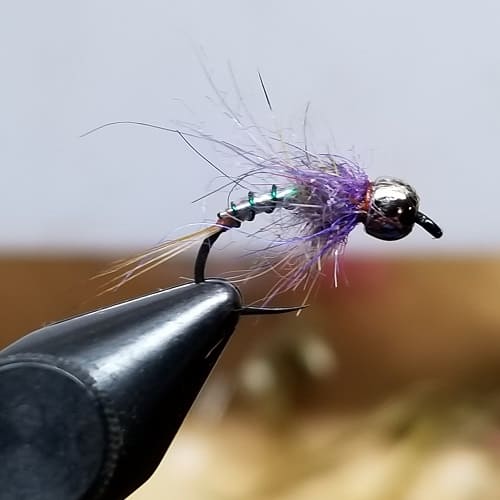
Flies can be purchased that to imitate the aquatic life of your local rivers.
Many fly fishers will tie flies thinking that they will be able to imitate the aquatic life better, but that is not always required.
As a beginner. I recommend just buying our flies from your local fly shop and once you get good at fly fishing then decide if you would like to take up fly tying
An advantage of tying flies is you can really tie up some unusual-looking flies, design new patterns, and make flies that might be hard to find in the fly shops or on-line.
If you are getting into fly tying, Fly Tying Kits are a great way to get started. Some kits have all the materials you need while other just have the vice and the tools.
Fly Fishing For Beginners Q&A
I think I’ve covered everything a new angler needs to know in this article. But, if you have questions, comments, or tips about fly fishing for beginners let us know in the comment section below.
Tight Lines,
Graham
